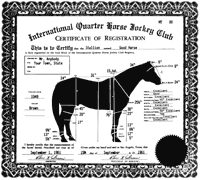Recently, I was reacquainted with the late Ben K. Green’s The Color of Horses
, a book that is less interesting (unless you are fascinated by pigmentation of horse hair) than it is a feast for the eyes, with 34 large color prints of Darol Dickinson’s stunning paintings. Dickinson’s subjects include Thoroughbreds, Quarter Horses, Morgans, Percherons, American Saddlebreds, Arabians, Standardbred, Belgians, Tennessee Walkers, and even an American “Native-bred.”
Originally printed in 1974, the book evolved from Green’s interest as a boy in horsemen’s preferences for and prejudices against certain coat colors. But it was when Green worked as a veterinarian in the rugged Trans Pecos region of Texas that his research really began. During the same period, he also wrote several popular books about his adventures as a horsetrader and a country vet, including Horse Tradin’, Wild Cow Tales
, and the The Village Horse Doctor
, which rank right up there with James Herriot’s bestseller All Creatures Great and Small
for local color and character.
Years ago, a friend of mine, who had worked for Green in the early 1960s, when he was trying to establish a breed registry called the International Quarter Horse Jockey Club Registry, shared some of the registry’s promotional literature with me. According to its by-laws, the purpose of the registry was to “sponsor the development of a superb Quarter Horse for the future by careful and continued infusion of proven Thoroughbred blood from approved quarter type individuals.”
 Acceptance into the registry required that a horse be inspected by a registry official and meet specific requirements for conformation, soundness and performance. All horses had to be three years or older to be eligible for inspection and minimum requirements for conformation were based on a chart of precise measurements for accepted heights (between14.2 hands to 15.3 hands) in quarter-hand increments.
Acceptance into the registry required that a horse be inspected by a registry official and meet specific requirements for conformation, soundness and performance. All horses had to be three years or older to be eligible for inspection and minimum requirements for conformation were based on a chart of precise measurements for accepted heights (between14.2 hands to 15.3 hands) in quarter-hand increments.
The minimum measurement requirements of a 15-hand horse, for instance, were – girth 73 1/2″; forequarters 43″; forearm 21 1/2″; knee 12″; front cannon 8 3/4″; front ankle 11″; front pastern 4 1/2″; stifle 41″; gaskin 18″; hock 16″; back cannon not less than 1″ larger than the front cannon and more is desirable;” back ankle not less than 1″ larger than the front ankle; and pastern a minimum of 5″ long or 1/2″ longer than the front pastern. Three exceptions were that stallions must be 1 1/2″ larger at the girth at all heights; 5 percent larger in bone structure at all heights; and a full 12″ larger around the hindquarters than around the forequarters.
The short (five questions) Q & A section of the registry’s promotional flyer throws light on some of the horses that Green anticipated having to inspect:
Q: What do you do about a mare or stallion that is wild and cannot be measured?
A. We will not register a horse without fully measuring him. After a wild horse has been caught, another rope can be fitted around his neck down close to the shoulder and this rope passed around the hind leg, while a back foot is then drawn up and securely tied to the shoulder. In most cases, a horse can be measured standing on three legs. However, if this is not sufficient, we can throw the horse on the ground, tie all four feet together and take all the necessary measurements. The height measurement can be obtained by forcing the wild horse into a chute or against a fence. We wish to state there is no horse that cannot be measured.
The International Quarter Horse Jockey Club Registry never caught on with breeders and owners, but if you’ve never read Ben K. Green’s Horse Tradin’, you’re in for a treat, when you do.
